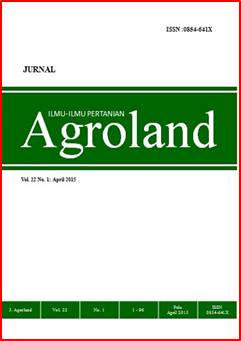Jumlah Inang Dan Kepadatan Parasitoid: Pengaruhnya Terhadap Perilaku Selfsuperparasitism Parasitoid Trichogramma chilotraeae Nagaraja & Nagarkatti (Hymenoptera: Trichogrammatidae)
Article History
Submited : July 17, 2020
Published : July 17, 2020
The aim of the research was to identify the influences of the number of hosts and the density of parasitoid on the behavior of selfsuperparasitism at Trichogramma chilotraeae. The behavior of selfsuperparasitism was studied by examining the percentage of selfsuperparasitism as affected by the variability of host number (3, 6, 12, 24 and 48) exposed to 1 and 2 female parasitoids. A descriptive analysis was conducted in order to identify an ovipositioning sequence. The results indicated that the number of hosts significantly affected the selfsuperparasitism percentage in the exposing treatments 1 and 2. The percentage of selfsuperparasitism was positively correlated with the ratio of the host number and the female parasitoid density. The tendency of the selfsuperparasitism behavior occurred in the early stage of ovipositioning. .
Bayram A, Salerno G, Conti E, Wajnberg E, Bin F, Kornosor S. 2004. Sex allocation in Telenomus busseolae, a solitary parasitoid of concealed eggs: the influence of host patch size. Entomologia Experimentalis et Applicata 111: 141-149.
Christy A.A. 2005. Kemampuan parasitisasi dan karakter morfologis trichogramma pretiosum riley dari dua jenis inang [Skripsi]. Bogor: Institut Pertanian Bogor.
Colazza S, Wajnberg. 1998. Effect of host egg mass size on sex ratio and oviposition sequence of Trissolcus basalis (Hymenoptera: Scelionidae). Population Ecology 27: 329-336.
Godfray, HCJ. 1994. Parasitoids: behavioral and evolutionary ecology. New Jersey: Princenton University Press.
Khan MS, Farid A, Ullah F, Badshah H. 2004. Effect of host and parasitoid density on parasitism efficiency of Trichogramma chilonis (Ishii). Asian Journal of Plant Science 3 (5): 647-650.
Nurindah. 2002a. Identifikasi parasitoid telur Trichogramma dan Trichogrammatoide. Dalam: Diseminasi Penerapan Pemanfaatan Parasitoid T. bactrae-bactrae (Nagaraja) sebagai Agens Hayati untuk Mengendalikan Hama Penggerek Polong Kedelai spp.. Malang: Balai Proteksi Tanaman Pangan dan Hortikultura Wilayah VI. 8 hal.
Ode PJ and Heinz KM. 2002. Host-size-dependent sex ratio theory and improving mass-reared parasitoid sex ratios. Biological Control 24: 31-41.
Schmidt JM. 1994. Host recognition and acceptance by trichogramma. Dalam: Wajnberg E, Hassan SA, editor. Biological Control with Egg Parasitoids. Wallingford: CAB International.
Suasa W. 2002. Nonpesticide methods for controlling desease and insect pest. Report of the APO seminar. Japan 10-17 April 2002. http/www.apo-tokyo.org [20 April 2006].
Wu ZX, Nordlund DA. 2002. Superparasitism of Lygus hesperus Knight eggs by Anaphes iole Girault in the laboratory. Biological Control 23: 121-126.
